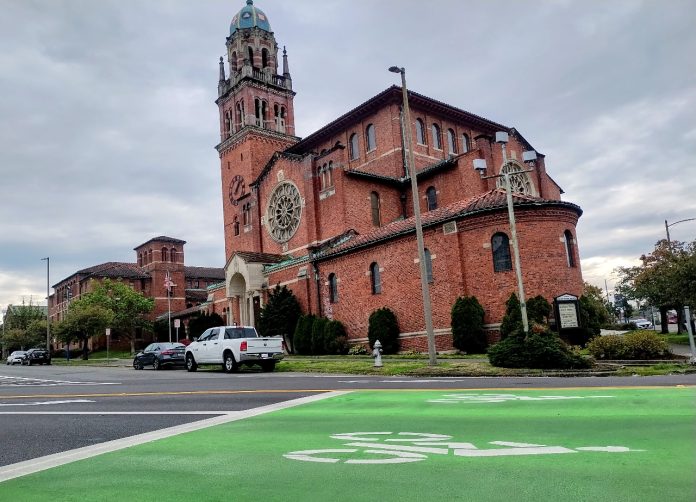
Washington’s third largest city is set to significantly reduce the amount of funding allocated to implementing its Vision Zero program in 2025 and 2026, if the proposed Tacoma city budget released earlier this month is adopted. A $900,000 budget in the 2023-2024 budget would be reduced to just $90,000, a 90% decrease that comes just a few years after Tacoma adopted a Vision Zero Action Plan in 2022.
Without a dedicated funding source for its Vision Zero program, the city has been left to fund vitally important safety improvements with one-time dollars, even with an existing transportation levy that contributes millions of dollars annually toward more car-focused projects. Tacoma spends the vast majority of its levy dollars on street repaving, and often those projects repave the street as is rather than adding safety features.
Meanwhile, crashes resulting in death and serious injury continue to rise on Tacoma’s streets, with a 35% increase between 2022 and 2023, according to Washington State Department of Transportation (WSDOT) data.

In 2020, Tacoma adopted its Vision Zero goal of “eliminating traffic fatalities and serious injuries in the City of Tacoma by 2035.” Unfortunately, the city is headed in the wrong direction to meet that goal.
Budget writers in the City of Destiny had a tough job this year, with a $24 million shortfall between revenue and anticipated expenditures in Tacoma’s general fund. But the Public Works department, which includes transportation, is actually set to see a $4.3 million increase for the next two years. While City Manager Elizabeth Pauli’s office specifically cited community safety as a top priority, that didn’t seem to extend to the city’s Vision Zero funding.
Funding for other programs that address transportation safety would largely stay the same or decrease, with a $300,000 cut to the fund for small projects to improve active transportation, and a $200,000 increase to the Safe Routes to School fund. Specific safety upgrade projects, particularly those funded by outside grants, will continue to be implemented over the coming years, but there will be less funding available to respond to immediate safety needs and opportunities that arise.
By way of comparison, Seattle spent $8.6 million on its Vision Zero program in 2024 and its upcoming transportation levy proposed to spend nearly $300 million on Vision Zero, Safe Routes to School, neighborhood safety projects, and bicycle safety over eight years.
Downtown On the Go, the preeminent transportation advocacy group in Tacoma, is concerned about the safety budget cuts. Laura Svancarek, who is the group’s interim executive director, told The Urbanist that the lack of dedicated funds could jeopardize safe streets progress in Tacoma.
“We are deeply concerned by the proposed reduction to Vision Zero funding in the biennial budget,” Svancarek said. “While we know that the City includes Vision Zero in its project prioritization, we believe it is important to have funds specifically earmarked for safety projects that cannot be pulled away to other projects.”
Tacoma’s Vision Zero Action Plan identifies a list of the city’s most dangerous corridors, which are deemed “high risk” due to a history of serious crashes and rampant speeding, where drivers are routinely exceeding the posted speed limit by at least 10 miles per hour. Thanks to a state grant, the City is moving forward with adding pedestrian crossing improvements to a stretch of 6th Avenue included on the list, but a more ambitious “Complete Streets” upgrade to 6th Avenue that would include protected bike lanes remains unfunded. The same is true for upgrades to 72nd and 74th Street in South Tacoma.

“Tacoma’s high crash corridors present complex problems which will be expensive to fix and require significant funding outside of the City’s budget,” Svancarek continued. “Dedicated Vision Zero dollars help City staff to win highly competitive grants by funding necessary studies and scoping without taking from already overly constrained department budgets such as active transportation. As Tacoma continues to see rising traffic fatalities and serious injuries, we need the City to invest meaningfully and specifically in traffic safety.”
Public Works Director Ramiro Chavez downplayed the impact of the direct reduction to the Vision Zero program in a statement to The Urbanist, pointing to the city’s investments more broadly in transportation.
“Our commitment to eliminating traffic fatalities and serious injuries by 2035 is unwavering,” Chavez said. “While you may not always see a specific ‘Vision Zero’ line item, this commitment is integrated throughout the proposed 2025-2026 Biennial Budget. Many of the prioritized projects and programs directly support our Vision Zero goals. For example, the Portland Avenue Vision Zero Improvements project recently secured $2.1 million in funding for preliminary engineering. This critical corridor has a history of serious and fatal accidents, and this project will allow us to conduct traffic studies, engage the community, and develop effective design solutions. Even with the current budgetary constraints, Vision Zero remains a top priority for the City of Tacoma.”
As the city heads toward a likely renewal of the Tacoma Streets Initiative levy in 2025, most of the public attention has been focused on how well the existing levy’s spending has improved the condition of the city’s roads. But without a dedicated Vision Zero funding source, Tacoma will likely continue to struggle to fund the safety improvements that are badly needed to start to address the city’s traffic safety emergency, with this year’s budget serving as a prime example.
Ryan Packer has been writing for The Urbanist since 2015, and currently reports full-time as Contributing Editor. Their beats are transportation, land use, public space, traffic safety, and obscure community meetings. Packer has also reported for other regional outlets including BikePortland, Seattle Met, and PubliCola. They live in the Capitol Hill neighborhood of Seattle.

